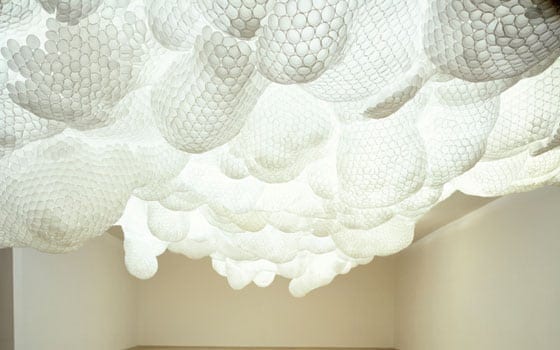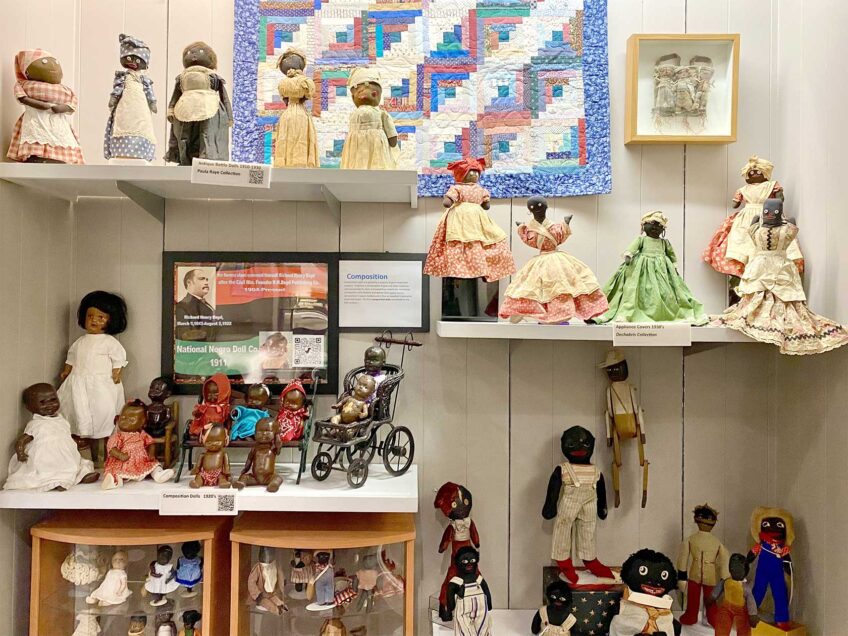




| At first glance, “Untitled (Paper Plates),” one of 16 works in Tara Donovan’s ICA exhibition, resembles a giant molecule. But a closer look reveals that the molecule consist of accordion-like layers of paper plates, folded and twisted together to form one large — and painstakingly detailed — work. (Photo courtesy of PaceWildenstein, New York) | The survey of Tara Donovan’s work now on view at the Institute of Contemporary Art/Boston showcases the sculptor’s singular talent for transforming seemingly mundane objects like Styrofoam cups and wooden toothpicks into vibrant, engaging art. (“Untitled (Styrofoam Cups)” Photo credit: Ace Gallery, Los Angeles, Courtesy PaceWildenstein, New York. “Untitled (Toothpicks)” and “Untitled (Toothpicks) (detail)” photos courtesy of PaceWildenstein, New York) |
Paper plates. Styrofoam cups. Plastic buttons. Wooden toothpicks. Sculptor Tara Donovan turns such ordinary things into objects of wonder. Her alchemy is on display until Jan. 4 at the Institute of Contemporary Art/Boston, which is hosting the first major survey of her career.
The exhibition of 16 works begins with a trio of cubes, each 3 feet tall. One consists of stacked panes of glass, another is a block of toothpicks, and the third is composed of straight pins. Each is a sort of stunt. Using only the forces of friction and gravity, the three cubes hold their shape. But they flaunt their fragility; at the edges of each, a few crumbs of glass, loose toothpicks or stray pins spill onto the floor.
Donovan’s cube is an odd hybrid: a whole that remains a bunch of parts, a solid that is both sturdy and delicate. She seems to enjoy such paradoxes.
Like her artistic ancestors, the ’60s Minimalists, Donovan explores an object and lets it remain intact. But unlike this earlier generation of artists, whose works might invite solemn contemplation of, say, a block of steel or a wooden plank, Donovan animates objects with fresh possibilities. Just as cells reproduce and, in the process, sometimes generate something new, she plays with the properties of an object and assembles many duplicates of the material into a form that lends it new life.
Donovan says her 1996 discovery that toothpicks could stick together “was the beginning of the process I still use.”
After college, Donovan worked as a waitress in Manhattan while conducting her artistic experiments. In 1996, a mushroom-like sculpture she made out of tarpaper stirred critical interest and she received a scholarship to enter Virginia Commonwealth University, graduating in 1999 with a Master of Fine Arts degree. A breakthrough show in 2003 at the Ace Gallery in New York was a turning point in her career — and she would no longer wait on tables.
Over the past five years, Donovan, 39, has garnered a number of prestigious prizes, including selection last month as one of 25 MacArthur Fellows for 2008. The MacArthur Foundation’s so-called “Genius” grants recognize achievers “on the very edge of discovery” and come with $500,000 in “no strings attached” support for their work.
Donovan is building a three-level residence and studio out of a former auto body shop in the Williamsburg section of Brooklyn, N.Y. The new quarters will provide ample space for her projects, which increasingly resemble organic life or evoke the movements of earth, ocean and sky.
A few pieces in the ICA survey do all these things at the same time.
In one gallery, semi-spherical bouquets of industrial Mylar sprawl across the floor like a colony of sea urchins. Clumped into groups of various sizes and shapes, the clusters call to mind the countless ways in which living creatures gather, connect and nurture one another. Surprisingly, this array of figures conveys the tranquility of a contemplative garden or a rock pool at low tide.
This 2008 installation, “Untitled (Mylar),” is also rich in optical illusion. Tear-shaped shadows within its shiny folds create patterns that resemble yin-yang symbols. From a distance, these same shadows approximate fur; from another angle, the figures become a constellation of dark domes inset with diamonds.
Covering a wall in the next gallery is last year’s “Untitled (Mylar Tape).” Tiny loops of Mylar look like droplets of water or bubbles as their oval reflections of light strike the wall. Shadows slither within the accordion-like layers of paper plates that are folded and twisted together to form “Untitled (Paper Plates),” which resembles a giant molecule.
In the nearby piece “Bluffs,” one of the few works with a title, spires of clear plastic buttons resemble a coral reef or stalagmites in a limestone cave. The name playfully hints at the artist’s interest in lending familiar objects a new guise.
Donovan does not tame industrial materials so much as discover and exploit their alluring properties, and let these behaviors take the material in new directions, a process not unlike evolution.
Once she comes up with a working model, Donovan undertakes a labor-intensive, manual process of assembling a project that may consist of thousands or even a million parts. The assembly, too, evokes the workings of nature, a slow accumulation of tasks like bees forming a honeycomb or spiders spinning a great web. She builds sculptures and adapts them to each exhibition site with a group of assistants, often female. Donovan describes the work as “very meditative, very peaceful … something between a group therapy session and a quilting bee.”
The results often exceed their sum of clever visual tricks and physical stunts. Donovan’s particular artistry is to transform the familiar into images that evoke and even duplicate the ceaseless processes of change and growth in nature. At the same time, her works are also about the infinite possibilities of seeing and the wonder of close looking. They invite the creativity of the viewer and reward imaginative attention: What you see changes as you approach, walk by or move away from each work.
From a distance, “Haze” may evoke a cloudbank, crinkled old taffeta or even the billows of an extravagant bubble bath. Close up, you face the open ends of plastic drinking straws. Wedged together by the thousands, the straws form a porous, wall-sized skin that is held in place by the corners of the room.
Donovan often finds her materials in dollar shops and industrial surplus stores. Plastic sheeting that she planned to use as studio drop cloth gained a new purpose after she discovered its captivating way of unfolding in translucent loops.
Layers of these polyester sheets fill a cut in a gallery wall in the concluding work of the exhibition, also “Untitled.” Behind it is a walkway with floor-to-ceiling windows that overlook Boston Harbor. Sunlight strikes the polyester sheets with an amber glow and their undulating lines suggest rippling surf or stained glass.
Take a closer look. As if seen through the lens of a pinhole camera, a glimpse of the city emerges from within the folds of polyester. Kaleidoscopic bursts of light frame a tiny panorama of the East Boston waterfront and a bright red tugboat chugging across the harbor. Here, Donovan’s alchemy transforms not only her material, but also the city itself.
Tara Donovan’s work is on view through Jan. 4, 2009 at the ICA/Boston, 100 Northern Avenue, Boston. The museum is open Tuesday through Sunday from 10 a.m. to 5 p.m., except on Thursday and Friday, when it is open until 9 p.m. Admission is $12 for adults, $10 for seniors and students, and free for children 17 and under.
For more information, call 617-478-3100 or visit www.icaboston.org.


![Banner [Virtual] Art Gallery](https://baystatebanner.com/wp-content/uploads/2024/04/Cagen-Luse_Men-at-store-e1713991226112-150x150.jpg)

![Banner [Virtual] Art Gallery](https://baystatebanner.com/wp-content/uploads/2024/04/Cagen-Luse_Men-at-store-e1713991226112-848x569.jpg)

